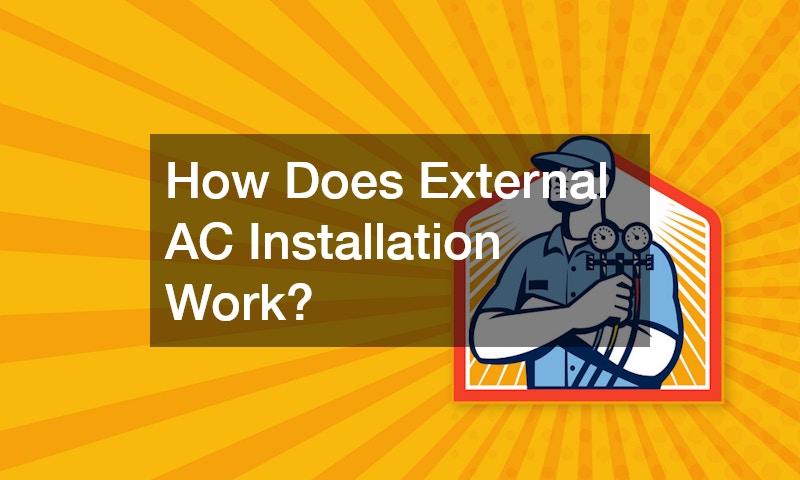External air conditioning (AC) units are essential for keeping homes and businesses cool, especially in areas with hot and humid climates. Installing an external AC unit involves several steps, each designed to ensure that the unit functions efficiently and safely. Whether you are planning to install a new unit or replace an old one, understanding the process of external AC installation in Kearneysville MD can help you make informed decisions and prepare for the installation day.
In this article, we’ll walk through the key steps of how external AC installation works, from choosing the right unit to ensuring proper placement and connection.
1. Choosing the Right AC Unit
The first step in the installation process is selecting the right external AC unit for your space. This decision is based on factors such as the size of the area you want to cool, your energy efficiency preferences, and your budget.
Size and Capacity
One of the most important factors to consider is the size or capacity of the AC unit. An undersized unit will struggle to cool your space effectively, while an oversized unit may cool too quickly without properly dehumidifying the air. To determine the correct size, you’ll need to calculate the square footage of the space you’re cooling and consult a professional to determine the appropriate BTU (British Thermal Unit) rating for your unit.
Energy Efficiency
Energy efficiency is another key factor. Look for AC units with high SEER (Seasonal Energy Efficiency Ratio) ratings, as these are more energy-efficient and can save you money on your energy bills in the long run. ENERGY STAR-certified units are also good options for maximizing efficiency.
2. Selecting the Location for the External Unit
Once you’ve selected the right unit, the next step is determining the best location for the external AC unit. Placement is critical for ensuring the system’s efficiency and longevity.
Clearance and Ventilation
The external AC unit needs to be placed in an area with plenty of clearance and ventilation. It should be installed on a flat, stable surface (typically a concrete pad) and positioned away from any obstructions such as walls, plants, or fences. Most manufacturers recommend leaving at least 12 to 24 inches of clearance around the unit to allow for proper airflow.
Shaded Area
Ideally, the unit should be placed in a shaded area to reduce the load on the compressor. Direct sunlight can cause the unit to work harder to cool the air, which can reduce efficiency and increase energy consumption.
Accessibility for Maintenance
The unit should also be positioned in a location that is easy to access for regular maintenance and repairs. This ensures that any necessary maintenance tasks, such as cleaning the coils or checking the refrigerant levels, can be performed without difficulty.
3. Installing the External AC Unit
The installation of the external AC unit is a complex process that should be handled by a professional HVAC technician to ensure it’s done safely and according to local building codes. Here are the key steps involved in the installation process:
Step 1: Installing the Pad
The external unit is typically mounted on a concrete or composite pad that helps keep it level and stable. This pad is installed before the unit is placed and ensures that the unit is elevated to protect it from water damage during rain or snow.
Step 2: Connecting Refrigerant Lines
The external AC unit is connected to the indoor components (typically the evaporator coil) via refrigerant lines. These lines carry refrigerant between the indoor and outdoor units, facilitating the cooling process. The lines are insulated to prevent energy loss and condensation.
Step 3: Electrical Wiring
The unit also needs to be connected to the electrical system. This involves running electrical wiring from the unit to the main power supply and installing a disconnect box near the unit for safety. The wiring ensures that the compressor and fans can operate as needed. This is a job that should only be done by a licensed electrician or HVAC technician, as improper wiring can be dangerous.
Step 4: Installing Drainage System
To remove condensation produced during the cooling process, an external AC unit needs a proper drainage system. This typically involves installing a condensate drain line to channel the water away from the unit and your home’s foundation.
4. Charging the System with Refrigerant
Once the external unit is installed and all the connections are in place, the next step is charging the system with refrigerant. Refrigerant is the substance that absorbs heat from inside your home and releases it outside. Most AC units are pre-charged with refrigerant, but if the system needs additional refrigerant, the technician will check and charge the system to ensure optimal performance.
Proper refrigerant levels are critical for the system to cool efficiently. Too little refrigerant can cause the unit to underperform, while too much can damage the compressor.
5. Testing the System
After the installation is complete, the technician will thoroughly test the system to ensure it’s working properly. This includes checking for refrigerant leaks, testing the electrical connections, and verifying that the unit is cooling the space effectively. The technician will also measure the airflow and make any necessary adjustments to the system’s settings.
6. Final Adjustments and Setup
Once the system is tested, the technician will go over any final adjustments needed, such as setting the thermostat and programming any smart controls if applicable. They will also provide instructions on how to use and maintain the system, including how to clean the unit and schedule regular maintenance checks.

